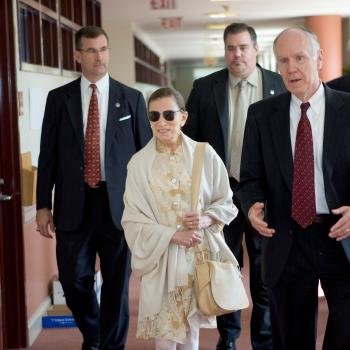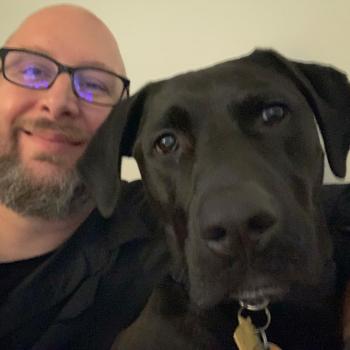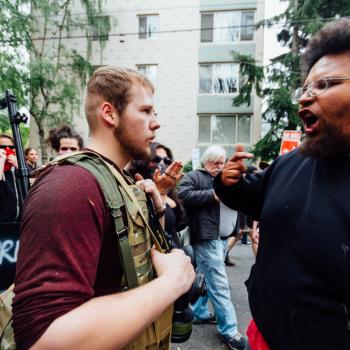We all make choices. We reap what we sow.
In the ten days since George Floyd was killed by Minneapolis police, protests and riots have broken out all around the globe. Here in the United States, although most protests began peacefully, in many locations police showed up in full riot gear and launched tear gas into crowds, escalating them to violence. Windows were smashed, buildings were burned, and stores were looted. There were assaults, frequently from those who opposed the protests. Many police departments responded with even greater force, including “kettling,” rubber bullets, driving police vehicles into crowds, and, unsurprisingly, reports from multiple cities of even more officers kneeling on protestors’ necks.
But it doesn’t have to be that way. By the second or third day of protests, police realized that gestures as simple as kneeling in solidarity for a few minutes could effectively deescalate an angry protest. In Des Moines, Iowa, for example, after days of escalation and violence, a local pastor negotiated with two separate police groups for just a few moments of kneeling and prayer, and another imminent riot was averted. Des Moines Police Chief Dana Wingert attributed this peaceful resolution to “community relationships” and “men and women that know the difference between right and wrong” on both sides.
. . .
A few miles up the road in Ames, Iowa—a town with a long history of both rioting and racial tension—things could have gone very badly. All the ingredients were there. A protest was organized on Facebook, largely leaderless with no one to take accountability for bad actors. Hundreds of angry citizens came. There were rumors of outside agitators. The KKK publicly planned, but did not execute, a counterdemonstration. The police were massively outnumbered. Some local civil rights leaders took took to social media begging protestors to call the event off. At least some sort of violence would be the natural outcome almost anywhere else…
But not here.
A few years back, under continued pressure from local activists, the Ames Police Department took a good, long look at how their policing was done. As a state, Iowa has one of the worst records in the nation for racial disparity in the justice system. As late as 2012, black residents of Ames were 5.5 times more likely than white residents to be arrested, a worse record, even, than Des Moines itself. Even now, the local university is dealing with a surge of racist incidents, similar to other parts of the nation. In response to all this and more, over the course of several years, the Ames Police Department has taken a number of internal and external measures to build better community relationships, eliminate implicit bias and discriminatory policing practices, and make the Ames community safer for everyone.
While many of the internal measures—like candidate screening, additional training, and enhanced review—are not immediately visible outside the department itself, some of the community measures are. Ames police show up in the local community with donuts and have candid, important conversations with local residents. Ames police show up at NAACP events, in visible acts of support and solidarity. Ames police show up to formal community dialogues on race and justice. Ames police show up, period.
This is not to lionize the Ames Police Department. Like any police department, their most important goals are aspirational, and improvement is a continuous process. Certainly problems still exist. But this does lay the groundwork and set the stage for what comes next.
When George Floyd was murdered by Minneapolis police, instead of hiding behind the “thin blue line,” the Ames Police Department chose to show up for racial justice again. Ames Police Chief Charles Cychosz released a statement condemning the Minneapolis officers’ actions in no uncertain terms, and identifying a number of specific steps the Ames police had already taken to make sure similar incidents would not happen there. Iowa State University’s Department of Public Safety, which works closely with the Ames Police Department, released a similar statement, with Chief Michael Newton saying, “we must do better.” And when the protests did finally come, the Ames Police Department showed up, not in riot gear, but in their regular patrol uniforms. And they mingled and knelt and marched with the protestors.
When asked why the Ames Police Department made the choices it did, Commander Jason Tuttle, the Ames PD Public Information Officer, had this to say:
When we saw the video we knew the officers’ tactics went against our training and procedures. We felt sickened by what happened to George Floyd. We started to get questions from community leaders on Wednesday evening. We met briefly on Thursday morning and decided we needed to make a strong statement of condemnation against the officers’ actions and inactions…
Tuttle pointed to the work the Ames PD has already done in the community, then continued:
This protest was a little different because no one reached out to us as the official organizer. We had several officers in the crowd, so we could listen and interact with them as they voiced their concerns and frustrations. We marched with them to demonstrate our concern for past police abuses and for what happened to George Floyd.
Tuttle also admitted, “we’ve learned from each riot in the past,” and pointed out specific choices, such as not showing up in riot gear, that came from these lessons.
Looking forward, Tuttle affirmed:
We will continue to work with our community and law enforcement partners to develop safe gathering spaces for future peaceful protests. We will continue to listen to our minority community and others who are under-represented. We are in the planning stages of having a round-table discussion in the near future with some community members in regards to use of force and police misconduct.
In other words, the Ames Police Department will continue to show up, even after this news cycle is over, and will continue to back their words with concrete actions.

. . .
A number of local civil rights leaders have responded both publicly and privately to the words and actions of the Ames Police Department over the past several days. The tone is cautiously optimistic, but leaders uniformly reinforce that words are not enough. Edna Young Clinton, for example, a 50-year resident of Ames and the President of the local branch of the NAACP, said in a statement:
Residents of Ames and Story County, we can no longer sit back and idyllically believe that this will not, or cannot, happen in our communities. Therefore, it is time that we do something. That we come together as a community and cease simply talking. Talking is no longer enough. There has to be some type of evidence to say and to indicate that policing in Ames, Iowa, is consciously, moment by moment, giving priority to protect and serve ALL in the truest sense of the words. I cannot tell you what that looks like, but I can tell you what I see and feel from a historical point of view of having lived in Ames for the past 50 years.
I believe we can do this; I believe we WILL do this. And now is the time!
Just one day later, in a second statement, Young Clinton confirmed that “a series of moderated community discussions with local law enforcement agencies and community leaders” will in fact take place, beginning on June 11, as a first step in this new process.
D. Keith Rollins, Jr., an organizer with Iowa Black Lives Matter, agrees with Young Clinton that there is more to be done. Rollins grew up in Ames, and recalls a number of bad experiences with local police. He states:
While I was encouraged at the things stated in the Ames PD’s press release, I have to say that it’s not enough. And the good thing is that whoever wrote the release understands they need to listen and remain open to what people of color in the community are saying by partnering with the NAACP chapter. I would expand this to all black leaders in the community. There is still so much work to do. There should not be any fear, nor hesitation in the declaration by the department, that Black Lives Matter. It should be on the front top of their webpage, in their press release, on their building.
Rollins continues:
I’m certain that the Ames PD knows what this would mean: persecution from people that disagree, perhaps even other departments in Iowa and the United States. To be clear, this is the line that people of color hold whether they wish to or not. If the Ames PD wishes to truly be an example to the Twin Cities, New York, LA, and others, then the stance that they need to take must be radical—as anything less than radical has clearly proven to be unacceptable in affecting change and rescuing black life.
. . .
But of course, while the importance of the police response (and proactive measures beforehand) can never be overestimated, de-escalation is a relational process, and the protestors have some hand in how things turn out too.
In a recent interview, Ames-based civil rights activist Abdullah Muhammad, who is affiliated with both Black Lives Matter and the NAACP, took on the structure of the protests in Ames. While it still is not clear who organized recent protest events, the driving force behind them appears to be well-meaning, progressive white people who for unknown reasons—perhaps inexperience—did not reach out to local leaders already established in the fight for racial justice. Muhammad sees a number of issues with this:
First, I spent the whole morning trying to figure out who planned it… It was a spontaneous event, which is good. That’s part of the up side and down side of BLM. It’s an organic structure without a central command. But the problem is had Saturday gone badly, it would have been, “look at those BLM protestors.”
Muhammad also points out, “I have a little bit of concern about white liberals coopting a movement.” Muhammad feels—as everyone seemed to agree that the Ames police were already on a good path—that there was no clarity about the “ask” from the protestors. A good opportunity was missed, for example, to build on previous success by pushing the Ames police to institute “external community auditing” of individual officer’s records as they move through their career.
As Muhammad is also a Christian leader in the community, he offered the forward-looking advice that “one of the best things you [white progressives looking to advocate change] can do right now—we need a clarion call within the church…. What does the Bible have to say about justice and fairness and restoration and reparation and reconciliation from square one?”
Not only do earlier civil rights movements in America have strong ties to prophetic voices within the church, but also, as Muhammad points out, the example of Christ is one of protest, even to the point of violence when no other alternative will work.
. . .
The Reverend Doctor Martin Luther King, Jr once said, “a riot is the language of the unheard.” If this is true—and this writer believes it is—then the corollary is that de-escalation is a matter of truly, deeply listening in ways that the community in protest knows their voices have, in fact, been heard. And the best way to do this, as the Ames example shows, is to take real, concrete action on the “ask” the protestors are making.
Commander Jason Tuttle is the Public Information Officer of the Ames Police Department. His contact information can be found here.
Edna Young Clinton is the President of the Ames Branch of the NAACP. The branch’s general contact information is here.
D. Keith Rollins, Jr. is an organizer with Iowa Black Lives Matter and a working musician. His Instagram is here and his email is [email protected].
Abdullah Muhammad is a local civil rights activist affiliated with both BLM and the NAACP. He facilitates implicit bias and antiracist workshops for the Ames community and beyond. His website is www.monarchtd.com and his email is [email protected].
DISCLAIMER—The work of social justice is relational, and the social justice world can be small. This author has had significant contact with the Ames Police Department, including Commander Tuttle, through his work in mental health; Rollins was a student of his at Iowa State University many years ago; Muhammad is a longtime friend and mentor; and he has heard Young Clinton speak on multiple occasions. They’re good people. You should listen.













